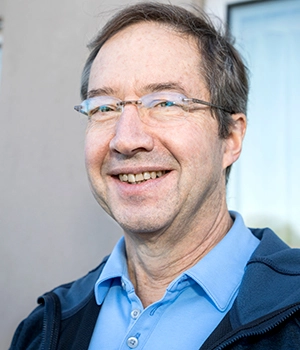As a young cardiologist and scientist at the University of California, San Francisco, in the US, Shaun Coughlin wanted to know more about the cellular conversations that trigger blood clotting. Clots are necessary to stop bleeding, but also can cause strokes and heart attacks. At the time, it had already been established that a molecule called thrombin triggered clotting. But it wasn’t clear what the receiving end of the cellular conversation, the cell surface receptor, looked like.
Others had attempted to solve this mystery without success, so the project was risky. “The outcome would be binary,” says Coughlin. “We would either find the receptor…or not.”
But Coughlin felt confident that the question he was asking was the right one. He also thought that new tools would succeed where traditional approaches had not. So he embarked on a series of studies that leveraged technologies he’d never used before – a daunting challenge for a beginning scientist.

Back then, the conversation between thrombin and cells, such as blood clotting platelets, occurred inside a black box, its details hidden. Decades later, gaps in understanding still persist in almost every cardiovascular and metabolic disease. Coughlin, who joined the Novartis Institutes for BioMedical Research (NIBR) on November 1 as Global Head of Cardiovascular and Metabolic Diseases, hopes to fill some of these gaps using the same strategy: Ask the right questions and choose the right approaches to answer them. For instance, he expects that emerging tools such as gene editing and novel models of cardiovascular disease will help NIBR researchers understand what drives cardiovascular diseases and find new ways to slow, reverse or prevent them.
Coughlin did end up finding the receptor he was looking for. His focus on understanding its underlying mechanisms and connection to disease ultimately led to new insight into how clots form and to a new clot prevention medicine.
Regarding risk, Coughlin admits that he had a luxury many scientists do not. “The worst case was that I’d enjoy taking care of patients as a cardiologist,” he says. “Not everyone is so fortunate, so I’m committed to giving people room to ask difficult questions.”
Here is an excerpt from a conversation with Coughlin about his career and the future of cardiovascular disease research.
What lessons did influential scientists teach you?
My graduate school mentor, Michael Moskowitz, and my postdoctoral mentor, Lewis “Rusty” Williams, were major influences. Both are extremely creative, critical and bold scientists – fearless and flexible enough to pick up whatever technique they feel is best to address the problem at hand. Both seek to understand mechanisms as deeply as possible. They also emphasized designing experiments that allow one to learn from failure. I like to think I internalized most of these lessons.
What are some of the open questions you have about cardiovascular and metabolic diseases?
Heart failure is a major problem and we know little about how the heart changes in this disease. For example, how does a defect in one part of the contraction machinery in a heart cell lead to remodeling of the whole heart? Similarly, atrial fibrillation – a heart rhythm disturbance that can cause strokes – is a scourge. We have little understanding of how most atrial fibrillation arises, much less how to prevent it. Atherosclerosis, also called hardening of the arteries, sometimes fades into the background, but it’s still important despite the progress that’s been made. There are unknowns in just about every step of the disease process. Some of the questions that come to mind now were around in the 1970s and even before, but today's technology may allow new insights. There’s plenty to chew on.
Do you have ideas about how to start answering open questions in the field?
We will mine human genetics and conduct patient-based studies to identify and probe determinants of disease. I hope to bring new tools to old questions, and explore new ideas in our early stage studies in inexpensive and efficient models. For example, zebrafish provide a powerful model system that I'd like to use to study tissue repair and inflammation. Because the fish are transparent, one can watch processes of interest. One can look at many fish in a day, and now with CRISPR gene editing technology, one can rapidly manipulate genes to see how they influence the process. It’s a very efficient system for learning more about the molecular mechanisms that drive inflammation and repair.
How do you know when a bold new research program is worth the risk?
We have to think about the overall path and how to generate enough meaningful data along the way to support further research and development. For instance, I think there are exciting things that one could try to more aggressively reverse atherosclerosis, and we can explore new ideas in disease models that are relatively cheap. One can be adventurous in such inexpensive studies to see if there’s a case to be made for more elaborate experiments and ultimately trials in people. That’s the art of it, to generate increasingly relevant evidence that can drive new therapies.
What is the appeal of doing research in industry, as opposed to continuing research in an academic lab?
There are huge unmet needs in heart failure, obesity, type 2 diabetes, atherosclerosis, heart rhythm disturbances and more. To be able to go from identifying an unmet medical need to selecting a biological process to modify, to discovering and developing a molecule that can alter that disease process, and taking that to a proof-of-concept study in humans, and working with a team that brings the diverse expertise necessary to do this, is incredibly appealing for a physician-scientist like myself.


